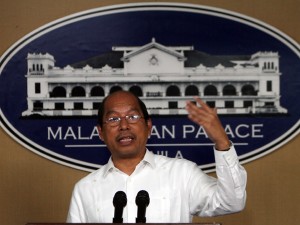Palace: PH not giving up vs China
MANILA, Philippines—Malacañang on Saturday said the Philippines would continue to press for a multilateral solution to territorial disputes in the region before the Association of Southeast Asian Nations (Asean) and other international fora.
A close adviser to President Benigno Aquino III, Budget Secretary Florencio Abad, acknowledged that the absence of a joint statement by the Asean on the ongoing dispute between the Philippines and China over the Panatag (Scarborough) Shoal was “a momentary setback.”
However, Secretary Ronald Llamas, the President’s adviser on political affairs, said it was “too early to say that the Asean efforts have failed.”
“We will continue to bring the issue up to Asean as well as at other international fora. It’s an issue that involves not just the Philippines but every country that has shorelines in the South China Sea,” added Communications Secretary Ricky Carandang.
Carandang said that in the drafting of a joint communiqué following the meeting of the foreign ministers, there was already a consensus to simply mention that there were discussions on disputes over shoals and similar outcrops in the contested waters. However, “Cambodia blocked the consensus,” he said.
Article continues after this advertisementThe Philippines is pushing for a code of conduct in what it calls the West Philippine Sea that would be binding to all claimant states, including China.
Article continues after this advertisement“Perhaps the recent tensions are still too fresh and the leadership transition in China is still in flux to allow the desired consensus on this initiative at this time,” Abad said in a text message.
“The prudent recourse is not to give up on the idea and continue to pursue the advocacy within the Asean and other fora through creative ways. It may well be a question of timing,” he added.
China reacts
China has dismissed accusations that it was responsible for the lack of a joint statement at the end of the 45th Association of Southeast Asian Nations Foreign Ministers Meeting held in Cambodia.
“China’s views and positions on issues in various fields were well-understood and received support from many countries,” Foreign Ministry spokesperson Liu Weimin said in an article published by China Daily Friday.
China earlier said that it is willing to discuss the Code of Conduct (COC) in the South China Sea with the Asean countries when conditions mature, Liu said in a separate article posted on the Chinese government web portal.
Del Rosario’s explanation
Explaining the controversy about the Asean joint statement, Del Rosario said: “We simply wanted the fact that we discussed the issue reflected in the joint communiqué, no more, no less. It would have just been a simple sentence or paragraph in the communiqué. We just want a recognition that the Scarborough Shoal was in fact discussed.”
Del Rosario said several Asean states and the Asean secretariat supported the Philippine position that the Scarborough Shoal discussion should be reflected on the joint statement.
“However, the chair [Cambodia] has consistently opposed any mention of the Scarborough Shoal at all in the joint communiqué…he said he doesn’t want to mention bilateral issues.”
Countered Del Rosario: “But if you look at many of the issues that we had, all of them have bilateral aspects to it.”
Reuters reported the Southeast Asian regional summit ended in acrimony on Friday over China’s assertive role in the strategic South China Sea, failing to agree on a concluding joint statement for the first time in its 45-year history.
Divisions between the 10 countries in the Asean follow a rise in incidents of naval brinkmanship involving Chinese vessels in the oil-rich waters that has sparked fears of a military clash.
Asean is composed of the Philippines, Indonesia, Malaysia, Singapore, Thailand, Brunei, Cambodia, Laos, Vietnam and Burma (Myanmar).
Potential flashpoint
The South China Sea has become Asia’s biggest potential military flashpoint as Beijing’s sovereignty claim over a huge, looping area has set it against Vietnam and the Philippines as the three countries race to tap possibly huge oil reserves.
The stakes have risen as the US military shifts its attention and resources back to Asia, emboldening its longtime ally the Philippines and former foe Vietnam to take a bolder stance against Beijing.
Asean’s divisions are an ominous sign for a bloc that wants to create a regional economic community by 2015 that would bring down barriers in trade, labor and financial markets—partly to compete with China for investment.
On the other hand, China is emerging as the biggest market and investor for Asian nations as markets in the West begin to shrink.
China is a member of the East Asian Summit and Asean Regional Forum which also held meetings in Cambodia.
The Philippines itself had earlier said it hoped the territorial dispute would not interfere with growing trade ties with the regional giant. With Reuters
